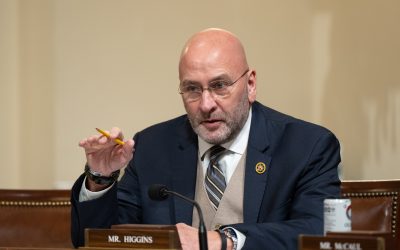WASHINGTON, D.C. – Congressman Clay Higgins (R-LA) participated today in a briefing on the 2019 Novel Coronavirus with Acting White House Chief of Staff Mick Mulvaney, Department of Health and Human Services Secretary Alex Azar, Department of Homeland Security Acting Deputy Secretary Ken Cuccinelli, Center for Disease Control Director Robert Redfield, M.D., and other senior Trump administration officials.
“The Trump administration is working proactively to mitigate Coronavirus impacts within the United States, and DHS has enacted enhanced screening methods at a number of U.S. airports,”said Congressman Higgins.“While confirmed cases of the Coronavirus remain isolated in the U.S., the public should continue to exercise caution and follow guidance from health officials.”
The following information is from the Department of Homeland Security (DHS):
DHS, its component agencies, and federal government partners are working with health professionals from the Centers for Disease Control and Prevention (CDC) to detect the virus and slow its spread in the United States.
Since cases of the virus began to emerge locally, U.S. Customs and Border Protection (CBP) and the DHS Countering Weapons of Mass Destruction (CWMD) office have been facilitating CDC’s enhanced health screening of travelers entering the U.S. with a nexus to Wuhan, China and the Hubei Province, or with recent travel to mainland China. This enhanced health screening began on January 17, 2020, at three U.S. airports and has since expanded progressively to 11 airports in a whole-of-government effort to mitigate the impact of the virus on Americans.
DHS has enacted the following multi-tiered airport screening procedures:
- Primary Inspection Procedures – officers will continue to identify all travelers having a nexus to the People’s Republic of China (excluding Hong Kong and Macau) within the previous 14 days of encounter. CBP will refer these identified travelers to secondary screening and will relay any information received from the traveler during the primary inspection, to include locations the traveler visited within the last 14 days while in Mainland China.
- Secondary Data Collection Procedures – CDC, CWMD contractors, and USCG personnel will conduct screenings on a standard basis, followed by referrals to CDC tertiary screening for positive hits. CBP will use their databases to collect, confirm, and provide the following information to CDC: name, primary and secondary phone numbers, emergency contact number, email address, and address of the location where the person will be for the next 14 days.
- Tertiary Additional Screening – CDC will arrange mandatory quarantine by medical professionals in cooperation with local health care facilities and local governments.
- Voluntary Quarantine Execution – according to CDC, once someone is identified for self-quarantine and health monitoring, the contact information provided by CBP to CDC will be securely transferred to the individual’s local public health officials for monitoring. Tracking, check-up timeline, and close-out with the traveler is accomplished by local public health officials and will vary across all states.
More information on the 2019 Novel Coronavirus is available from the CDC here.



